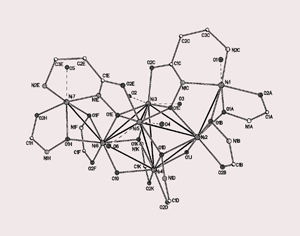Synthesis and structure of a heptanuclear nickel(ii) complex uniquely exhibiting four distinct binding modes, two of which are novel, for a hydroxamateligand
Abstract
The reaction of 2-(dimethylamino)phenylhydroxamic acid (2-dmAphaH) with NiSO4·6H2O gives the complex [Ni7(2-dmAphaH−1)2(2-dmApha)8(H2O)2]SO4·15H2O uniquely exhibiting four distinct hydroxamate binding modes, two of which are novel, and showing both antiferromagnetic and ferromagnetic interactions in contrast to [Cu5(2-dmAphaH−1)4(HSO4)2(MeOH)2]·2MeOH, a strongly antiferromagnetic metallacrown formed with CuSO4·5H2O.


 Please wait while we load your content...
Please wait while we load your content...